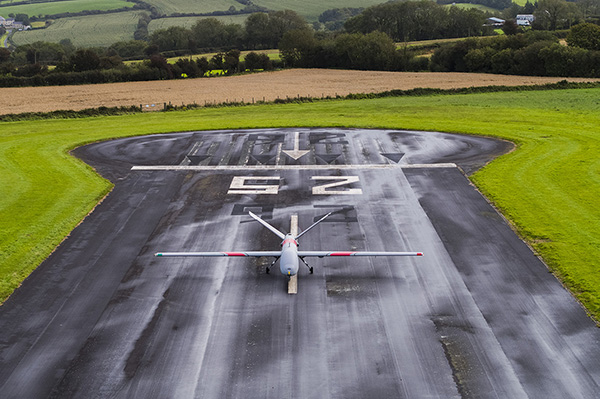First unmanned Search & Rescue trial flight could revolutionise emergency response at sea
26 November 2020During a recent series of trial flights, we have been working closely with the Maritime Coastguard Agency (MCA) to assess how remotely piloted and unmanned aircraft could be used during future search and rescue operations performed by Her Majesty’s Coastguard, the search and rescue arm of the MCA.
The trials, which happened in September of this year, involved several test flights and were carried out using a remotely piloted Elbit Hermes 900 aircraft. This included a single 10-hour sortie where the aircraft took off from West Wales Airport (Aberporth), transited controlled airspace and performed a low-level overwatch mission in Oceanic Airspace off the south-west coast of Ireland.
An unmanned aircraft passing through controlled airspace alongside commercial manned traffic is a complex operation and close involvement was required from the team at our Swanwick air traffic control centre to plan, communicate and conduct the operation safely.
On its outbound leg, the aircraft spent around two hours in communication with Swanwick – covering 50 nautical miles through controlled UK airspace to the boundary with the Republic of Ireland’s airspace, where it was successfully transferred to Shannon Control.

Unlike many unmanned flight trials which operate in their own segregated areas, the Hermes 900 was handled by air traffic controllers in the same way as other manned aircraft. The team at Swanwick leveraged the expertise they developed in previous projects to enable the aircraft to fly safely in controlled airspace, despite the pilot being many miles away on the ground at West Wales Airport.
The most obvious difference was the speed of the aircraft itself. This particular one – the Hermes 900 – has a cruising speed of 65 knots (75mph) and an operational ceiling of 30,000ft. On the day of the trial it was initially flying into a strong westerly headwind over Pembrokeshire and the Irish Sea, which resulted in an average groundspeed of just 22 knots. This presented a host of problems in terms of safely integrating with aircraft flying at normal cruising speeds (c. 450 knots) – rather like riding a pushbike along a motorway! Thanks to the team at Swanwick this issue was identified beforehand, and it was alleviated by ensuring the drone flew at the lowest available Westbound flight level (16,000ft) to allow faster jet traffic to overtake by passing safely above it.
The trial was a significant milestone for the MCA in evaluating how unmanned and remotely piloted aircraft could support the next generation of search and rescue for HM Coastguard, as well as highlighting the potential for aircraft to be used in critical counter pollution work and for the protection of the wider marine environment. The MCA has and is continuing to work closely with other government departments and agencies to share selected report contents and information regarding the successful trials.
And from a NATS and ATM perspective, the flight was a complete success, with the aircraft flying its planned route within controlled airspace, remaining in communication with the team at Swanwick and safely separating from other air traffic at all times. Unmanned Aerial Vehicles (UAVs) in all their forms are an inevitable part of our future and the demand for these aircraft is helping to drive the development of tools to assist in their safe control.
NB Imagery used by kind permission of the Maritime Coastguard Agency & Elbit Systems
Comments
Please respect our commenting policy and guidelines when posting on this website.

26.11.2020
09:42
Peter Lubrani
The complexity of a fleet of Coastguard UAVs is understood from an ATM point of view, nonetheless the benefits are vast in terms of surveillance, cost, endurance and timely Rescue response among others.
26.11.2020
10:27
Bruce Dean
Very interesting article and good to see new technology solutions being evaluated to enhance search & rescue capability. Nice work for everyone involved.
26.11.2020
16:18
Dereck James
Not to put a downer on the ‘first drone’, but they have been using search drones all year in the Dover Straits. It’s based out of Lydd and started full operations a good few months before the first Abberporth test.
For reference they have been operating in D098 and D097
The French have been using them too!
Sorry to be the bearer of bad news.
26.11.2020
23:59
Brian Binns
As a model aeroplane pilot, I effectively fly UAV’s to VFR. I know only too well the problems of differing speeds relative to aircraft size as models come in all scales. It is great to see that you are overcoming these and other challenges in this very important field. So when legislation finally squeezes model flyers out of the sky I hope you all remember who took the initial steps to develop “UAV’s” with our rubber band models and valve radios. Seriously god job, well done.
27.11.2020
11:53
JamesMorgan
An additional asset for HMG to patrol UK waters
02.12.2020
07:21
Will Barnes
It’s exciting to see the result of this programme so far and interesting to understand more about the role NATS played in it. Look forward to hearing more.